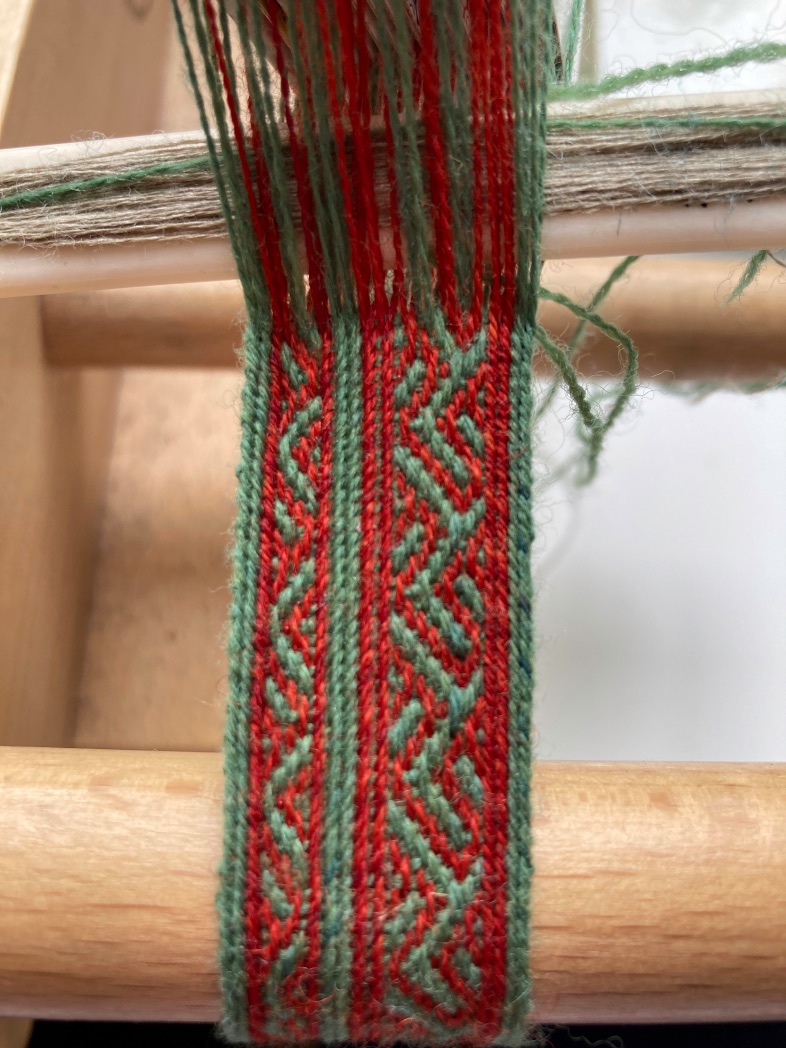Ein Band aus Sasso di Fubara

Eines der ältesten bisher erwähnten Brettchengewebe stammt aus einem Grab in der Nekropole von Sasso di Fubara in Italien aus der Villanova-Zeit und wird auf das 8. Jahrhundert v. Chr datiert.
Furabara Masurel beschrieb es in seiner Publikation von 1992 als schmales Band mit fünf verschiedenen Musterzonen in Längsrichtung, die von Zonen mit einfachen, einfarbigen Brettchenschnüren begrenzt werden. Die äußersten sind rot, die inneren braun. Seinen Untersuchungen zufolge wurden dreieckige Brettchen verwendet. Er beschreibt, dass das Muster durch Kett- und Schussfäden gebildet wird. Die Schussfäden erscheinen auf der Oberfläche so, dass sie ein Motiv bilden.
One of the oldest tablet woven fabrics mentioned so far comes from a grave in the Villanova period necropolis of Sasso di Fubara in Italy, dating from the 8th century BC.
Furabara Masurel described it in his 1992 publication as a narrow band with five different pattern zones in the longitudinal direction, bordered by zones with simple, single-coloured tabled strings. The outermost tablet strings are red, the inner one’s brown. According to his research, triangular tablets were used. He describes that the pattern is formed by warp and weft threads. The weft threads appear on the surface in such a way that they form a motif.
Auch hier wird eine schmale brettchengewebte Bordüre erwähnt, die in der gleichen Technik wie Verrucio (also mit dreieckigen Brettchen) gewebt wurde. Neben einem nicht sehr hochauflösenden Bild des Fundes gab es auch eine Rekonstruktion des Musters in dem Artikel "Iron Age textiles from Sasso di Furbara, Italy: Preliminary results of new scientific investigation", wo zwei Musterzonen zu sehen sind (im Gegensatz zu den fünf von F. Masurel.) Hier ist die Borte in Grün und Rot gearbeitet. Im Gegensatz zu Masurels Beschreibung und dem Fund sind die Schussfäden der Rekonstruktion kaum sichtbar.
Da der Bericht beschreibt, dass das Material im Laufe der Jahrhunderte geschrumpft ist, kann es gut sein, dass die Schussfäden im Original nur sichtbar waren, weil die Kettfäden geschrumpft waren.

Here, too, a narrow tablet-woven border is mentioned that was woven using the same techniques as Verrucio (i.e. with triangular tablets.) Apart from a not very high-resolution picture of the find, there was also a reconstruction of the pattern in the article “Iron Age textiles from Sasso di Furbara, Italy: Preliminary results of new scientific investigation,” where two pattern zones are seen (in contrast to the five by F. Masurel.) Here the border is worked in green and red. In contrast to Masurel’s description and the find, the weft threads of the reconstuction are barely visible.
Since the report describes the material as having shrunk over the centuries, it may well be that the weft threads were only visible in the original because the warp threads had shrunk.
Ich habe nicht versucht, das Muster mit der Dreilochtechnik mit dreieckigen Brettchen zu rekonstruieren, sondern habe versucht, das Muster sichtbar zu machen, also habe ich mich für eine Zweilochtechnik im Musterbereich entschieden und habe 4 Fäden für die einfarbigen Brettchen gewählt.
Das Muster kommt sehr schön heraus, die Zweilochtechnik lässt auch den Schuss wie im Original erkennen (wenn auch nicht so stark), aber die Struktur des Gewebes bei den einfarbigen Brettchen unterscheidet sich sehr von dem Fundstück/Rekonstruktion im Artikel (wie erwartet). Ein neuer Versuch wird folgen.  Einen Link zu einer Musteranleitung findet ihr in den Anleitungen / Click for the manual
Einen Link zu einer Musteranleitung findet ihr in den Anleitungen / Click for the manual
I didn’t try to reconstruct the pattern using the three-hole technique with triangular tablets, but tried to rework the pattern, so I opted for a two-hole technique in the pattern area and have chosen 4 threads for the plain threaded tablets.
The pattern comes out beautifully, the two-hole technique also allows the weft to be seen as in the original (although not as strongly), but the structure of the fabric on the single-colour tablets is very different from the find/reconstruction in the article (as expected). A new attempt will follow.
Literatur:
Margarita Gleba: Tracing textile cultures of Italy and Greece in the early first millennium BC, 2016
Margarita Gleba, Ettore Pizzuti, Ina Vanden Berghe, Mathieu Boudin, Alessandra Serges, Alessandra Montedoro, Iron Age textiles from Sasso di Furbara, Italy: Preliminary results of new scientific investigation, in PURPUREAE VESTES VII Textiles and Dyes in Antiquity 2020
Mamez and H. Masurel, “Étude complémentaire des vestiges textile trouvés dans l’embarcation de la nécropole du Caolino à Sasso di Furbara,” 1992
